Linguistics and Applied Linguistics publications
2020
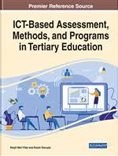
Almaki, Mansoor and Gruba, Paul. “Conceptualizing Formative Blended Assessment (FBA) in Saudi EFL,” in Yilan, Serpil Meri and Koruyan, Kasim. ICT-based assessment, methods, and programs in tertiary education. IGI Global, 2020.
The use of information and communication technologies (ICTs) in education has revolutionised learning. Shifting beyond traditional mode of education, the integration of ICTs has become an advantage for students at tertiary education when used for the right purpose to enhance learning. The use of technology brings forth a flexible and accessible mode of education and bridges the gap of learning across borders. This enables students at tertiary level to have access to other universities and academic resource materials globally, thereby expanding their knowledge. Thus, it is crucial to consider the development of technology in education as part of a comprehensive pedagogical framework and take into account new developments in ICTs. More information...

Goddard, Cliff and Defina, Rebecca. Pitjantjatjara / Yankunytjatjara to English Dictionary. Revised Second Edition. IAD Press, 2020.
Pitjantjatjara and Yankunytjatjara are two neighbouring dialects of the Western Desert language. They are spoken over a wide area of the Northern Territory and South Australia, stretching from Areyonga in the north to Coober Pedy in the south, along the Western Australia border and as far east as Oodnadatta. The new 316-page Revised Second Edition, compiled by Cliff Goddard and now Updated by Rebecca Defina, includes more entries in a compact 17x24cm size you can easily hold. More information...

Knoch, Ute and Macqueen, Susy. Assessing English for Professional Purposes. Routledge Research in English for Specific Purposes, 2020.
Assessing English for Professional Purposes provides a state-of-the-art account of the various kinds of language assessments used to determine people’s abilities to function linguistically in the workplace. At a time when professional expertise is increasingly mobile and diverse, with highly trained professionals migrating across national boundaries to apply their skills in English-speaking settings, this book offers a renewed agenda for inquiry into language assessments for professional purposes (LAPP). More information...
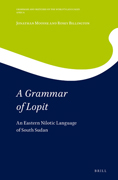
Moodie, Jonathan and Billington, Rosemary. A Grammar of Lopit: An Eastern Nilotic Language of South Sudan. Brill Academic Publishers, 2020.
In A Grammar of Lopit, Jonathan Moodie and Rosey Billington provide the first detailed description of Lopit, an Eastern Nilotic language traditionally spoken in the Lopit Mountains in South Sudan. Drawing on extensive primary data, the authors describe the phonology, morphology, and syntax of the Lopit language. Their analyses offer new insights into phenomena characteristic of Nilo-Saharan languages, such as ‘Advanced Tongue Root’ vowel distinctions, tripartitite number marking, and marked-nominative case systems, and they uncover patterns which are previously unattested within the Eastern Nilotic family, such as a three-way contrast in aspect, number marking with the ‘greater singular’, and two kinds of inclusory constructions. This book offers a significant contribution to the descriptive and typological literature on African languages. More information...

Vaughan, Jill. “The ordinariness of translinguistics in Indigenous Australia,” in Lee, Jerry Won and Dovchin, Sender (eds.,). Translinguistics: Negotiating Innovation and Ordinariness. Routledge – Taylor & Francis, 2020.
Translinguistics represents a powerful alternative to conventional paradigms of language such as bilingualism and code-switching, which assume the compartmentalisation of different ‘languages ’ into fixed and arbitrary boundaries. Translinguistics more accurately reflects the fluid use of linguistic and semiotic resources in diverse communities. This ground-breaking volume showcases work from leading as well as emerging scholars in sociolinguistics and other language-oriented disciplines and collectively explores and aims to reconcile the distinction between ‘innovation’ and ‘ordinariness’ in translinguistics. More information...
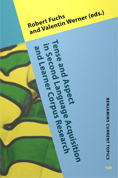
Zhao, Helen and Shirai, Yasuhiro. “Arabic learners’ acquisition of English past tense morphology: Lexical aspect and phonological saliency,” in Fuchs, Robert and Werner, Valentin (eds.,). Tense and Aspect in Second Language Acquisition and Learner Corpus Research. John Benjamins Publishing Company, 2020.
The expression of temporal relations, notably through tense and aspect, is central in all processes of communication, but commonly perceived and described as a major hurdle for non-native speakers. While this topic has already received considerable attention in the SLA literature, it features less prominently in recent corpus-based studies of learner language. This volume intends to close this gap. More information...
2019
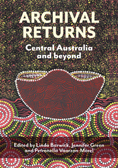
Barwick, Linda, Green, Jennifer and Vaarzon-Morel, Petronella (eds.,). Archival returns: Central Australia and beyond. University of Hawai’i at Mānoa and Sydney University Press, 2019.
Green, Jennifer, Ellis, Elizabeth Marrkilyi and Kral, Inge. “i-Tjuma: The journey of a collection – from documentation to delivery,” in Barwick, Linda, Green, Jennifer and Vaarzon-Morel, Petronella (eds.,). Archival returns: Central Australia and beyond. University of Hawai’i at Mānoa and Sydney University Press, 2019.
Nordlinger, Rachel, Green, Ian and Hurst, Peter. “Working at the interface: the Daly Languages project,” in Barwick, Linda, Green, Jennifer and Vaarzon-Morel, Petronella (eds.,). Archival returns: Central Australia and beyond. University of Hawai’i at Mānoa and Sydney University Press, 2019.
Place-based cultural knowledge – of ceremonies, songs, stories, language, kinship and ecology – binds Australian Indigenous societies together. Over the last 100 years or so, records of this knowledge in many different formats – audiocassettes, photographs, films, written texts, maps, and digital recordings – have been accumulating at an ever-increasing rate. Yet this extensive documentary heritage is dispersed... Archival Returns: Central Australia and Beyond explores the strategies and practices by which cultural heritage materials can be returned to their communities of origin, and the issues this process raises for communities, as well as for museums, galleries, and other cultural institutions. More information...

Gruba, Paul. “Social perspectives on language testing,” in Roever, Carsten and Wigglesworth, Gillian (eds.,). Social perspectives on language testing: Papers in honour of Tim McNamara. Peter Lang, 2019.
Gruba, Paul. “The challenge of theory: Social media and language assessment,” in Roever, Carsten and Wigglesworth, Gillian (eds.,). Social perspectives on language testing: Papers in honour of Tim McNamara. Peter Lang, 2019.
Roever, Carsten and Wigglesworth, Gillian (eds.,). Social perspectives on language testing: Papers in honour of Tim McNamara. Peter Lang, 2019.
Tim McNamara’s work has had a fundamental impact on language testing. This volume brings together over 20 leading scholars in language assessment whose work has been influenced by Tim McNamara. Their papers cover issues of the social impact of language tests, such as fairness and justice of test use and language testing in the context of migration. They also address testing of interaction, and teachers’ and students’ views of language tests. More information...
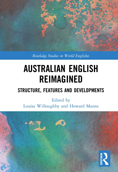
Loakes, Deborah. “Sociophonetics of Australian English,” in Willoughby, Louisa and Manns, Howard (eds.,). Australian English Reimagined: Structure, Features and Developments. Routledge, 2019.
The volume first explores particular structural features where Australian English differentiates itself from other English varieties. There are chapters on phonetics and phonology, socio-phonetics, lexicon and discourse-pragmatics as these elements are core to understanding any variety of English, especially within the World Englishes paradigm. It then considers what are arguably the most salient aspects of variation within Australian English and finally focuses on historical, attitudinal and planning aspects of Australian English. More information...

Mansfield, John. Murrinhpatha Morphology and Phonology. De Gruyter Mouton, 2019.
Murrinhpatha is an Australian Aboriginal language spoken in a region of tropical savannah and tidal inlets on the north coast of the continent. Some 3000 speakers live mostly in the towns of Wadeye and Nganmarriyanga, though they maintain close ties to their traditional lands, totems and spirit ancestors. Murrinhpatha word structure is highly complex, and quite distinct from the better-known Pama-Nyungan languages of central and southern Australia. Murrinhpatha is characterised by prolific compounding, clitic clusters, cumulative inflection, irregular allomorphy and phonological assimilation. This book provides a comprehensive account of these phenomena, giving particular attention to questions of morphological constituency, lexical storage, and whether there is really such thing as a ‘word’ unit. More information...

McNamara, Tim, Knoch, Ute and Fan, Jason. Fairness, Justice and Language Assessment. Oxford University Press, 2019.
This book has two goals, each related to the validity of language assessment. The first goal is to explore the difference between fairness and justice in language assessment. The authors distinguish internal and external dimensions of the equitable and just treatment of individuals taking language tests which are used as gatekeeping devices to determine access to education and employment, immigrant status, citizenship, and other rights. The second goal is to show how the extent of test fairness can be demonstrated and improved using the tools of psychometrics, in particular the models collectively known as Rasch measurement. More information...

Nordlinger, R., Bond, O. and Meakins, F. “Prominent possessor indexing in Gurindji,” in Bárány, András; Bond, Oliver and Nikolaeva, Irina (eds.,). Prominent Internal Possessors. Oxford University Press, 2019.
This volume is the first to provide a comprehensive cross-linguistic overview of an understudied typological phenomenon, the clause-level argument-like behaviour of internal possessors... Following an introduction to the typology of the phenomenon and an overview of possible syntactic analyses, chapters in the volume offer more focussed case studies from a wide range of languages spoken in the Americas, Eurasia, South Asia, and Australia. More information...

Storch, Neomy. “Collaborative Writing as Peer Feedback,” in Hyland, Ken and Hyland, Fiona (eds.,). Feedback in Second Language Writing: Contexts and Issues. 2nd edition. Cambridge University Press, 2019.
Collaborative writing is the co-authoring of a text by two or more writers. During the joint composing process, learners deliberate and provide each other with feedback about all aspects of the text: on the structure, content and language. In this chapter, I draw on a growing number of studies that have investigated collaborative writing to illustrate the distinguishing traits of peer feedback. In collaborative writing, the peer feedback is immediate, responding directly to a need that arises during the composing process. More information...
2018
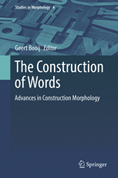
Baker, Brett. “Super-Complexity and the Status of ‘Word’ in Gunwinyguan Languages of Australia,” in Booij, G. (ed.,). The Construction of Words: Advances in Construction Morphology. Springer, 2018.
This volume focuses on detailed studies of various aspects of Construction Morphology, and combines theoretical analysis and descriptive detail. It deals with data from several domains of linguistics and contributes to an integration of findings from various subdisciplines of linguistics into a common model of the architecture of language. It presents applications and extensions of the model of Construction Morphology to a wide range of languages. More information...
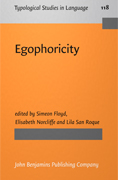
Kelly, Barbara. “Interactions of speaker knowledge and volitionality in Sherpa,” in Floyd, Simeon; Norcliffe, Elisabeth and San Roque, Lila (eds.,). Egophoricity. Typological Studies in Language 118, 2018.
This chapter investigates evidentiality and egophoricity in Sherpa, spoken in eastern Nepal. It seeks to build on existing accounts of Sherpa evidentials through an investigation of what triggers evidential and egophoric markers. I show that in some instances the trigger appears to be grammatically and temporally-based, in others it is speaker knowledge or evidence-based and in others it is motivated by the volitionality of the agent. The relations between each of these factors is examined here as part of an overall investigation into the Sherpa verbal system. More information...
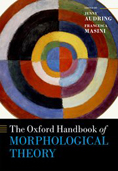
Sadler, L. and Nordlinger, R. “Morphology in Lexical-Functional Grammar and Head-driven Phrase Structure Grammar,” in Audring, Jenny and Masini, Francesca (eds.,). Oxford Handbook of Morphological Theory. Oxford University Press, 2018.
This volume is the first handbook devoted entirely to the multitude of frameworks adopted in the field of morphology, including Minimalism, Optimality Theory, Network Morphology, Cognitive Grammar, and Canonical Typology. Following an introduction from the editors, the first part of the volume offers critical discussions of the main theoretical issues within morphology, both in word formation and in inflection, as well as providing a short history of morphological theory. More information...
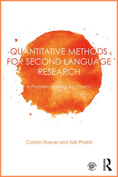
Roever, C. and Phakiti, A. Quantitative Methods for Second Language Research A Problem-Solving Approach. Routledge, 2018.
Quantitative Methods for Second Language Research introduces approaches to and techniques for quantitative data analysis in second language research, with a primary focus on second language learning and assessment research. It takes a conceptual, problem-solving approach by emphasising the understanding of statistical theory and its application to research problems while paying less attention to the mathematical side of statistical analysis. The text discusses a range of common statistical analysis techniques, presented and illustrated through applications of the IBM Statistical Package for Social Sciences (SPSS) program. More information...
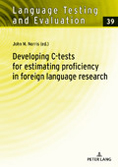
Roever, Carsten. “Developing C-tests across eight languages: Discussion,” in Norris, John (ed.,). Developing C-tests for estimating proficiency in foreign language research. Language Testing and Evaluation series. Peter Lang, 2018.
This book explores the development of C-tests for providing efficient measures of foreign language proficiency in eight different languages: Arabic, Bangla, Japanese, Korean, Turkish, French, Portuguese, and Spanish. Researchers report on how C-test principles were applied in creating the new language tests, with careful attention to language-specific challenges and solutions.

Simpson, Jane, Vaughan, Jill and Wigglesworth, Gillian (eds.,). Language Practices of Indigenous Children and Youth The Transition from Home to School. Palgrave Macmillan, 2018.
This book explores the experiences of Indigenous children and young adults around the world as they navigate the formal education system and wider society. Profiling a range of different communities and sociolinguistic contexts, this book examines the language ecologies of their local communities, schools and wider society and the approaches taken by these communities to maintain children’s home languages. The authors examine such complex themes as curriculum, translanguaging, contact languages and language use as cultural practice. More information...
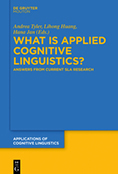
Zhao, Helen, Yau, Thomas Siu-ho, Li, Keru and Wong, Noel Nga-yan. “Polysemy and conceptual metaphor: A cognitive linguistics approach to vocabulary learning,” in Tyler, Andrea; Huang, Lihong and Jan, Hana (eds.,). What is applied cognitive linguistics? Answers from current SLA research. Mouton de Gruyter, 2018.
Many SLA professionals remain unaware of what CL and Applied Cognitive Linguistics are and of the tremendous potential these approaches offer for our understanding of L2 learning and pedagogy. The volume addresses this gap by presenting theoretically-grounded, empirically-based studies which illustrate the application of key concepts of CL and demonstrate the efficacy of using the concepts in the classroom or in basic L2 research. More information...
2017
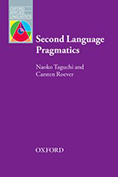
Taguchi, Naoko and Roever, Carsten. Second Language Pragmatics. Oxford University Press, 2017.
Taguchi and Roever present the latest developments in second language pragmatics research, combining acquisitional and sociolinguistic perspectives. They cover theories of pragmatics learning and research methods in investigating pragmatics, linking these with findings on the acquisition of second language pragmatics and with practice in teaching and assessing pragmatics. More information...
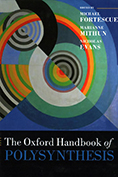
Forshaw, W., Davidson, L., Kelly, Barbara, Nordlinger, Rachel, Wigglesworth, Gillian and Blythe, Joe. “The acquisition of Murrinhpatha (Northern Australia),” in Fortescue, M., Mithun, M. and and Evans, N. (eds.,). The Oxford Handbook of Polysynthesis. Oxford University Press, 2017.
This handbook offers an extensive crosslinguistic and cross-theoretical survey of polysynthetic languages, in which single multi-morpheme verb forms can express what would be whole sentences in English. More information...
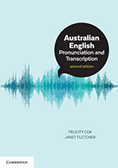
Cox, Felicity and Fletcher, Janet. Australian English Pronunciation and Transcription (2nd edition). Cambridge University Press, 2017.
Australian English Pronunciation and Transcription is the first textbook to clearly describe Australian English speech patterns. Now in its second edition, this ground-breaking work addresses speech production characteristics and provides detailed instruction in both phonetic and phonemic transcription of the dialect. More information...
2016
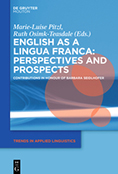
McNamara, Tim and Shohamy, E. “Language testing and ELF: Making the connection,” in Pitzl, M-L. And Osimk-Teasdale, R. (eds.,). English as a Lingua Franca: Perspectives and Prospects. De Gruyter, 2016.
In the past 15 years, English as a lingua franca (ELF) has evolved from a ‘niche topic’ of a relatively small group of specialists to a highly productive research area that now has a firm place on the map of linguistics. Looking back (as well as forward), this edited volume addresses perspectives and prospects of ELF in connection with other areas of linguistics. More information...
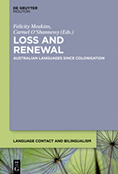
Baker, Baker. “Fact or Furphy? The Continuum in Kriol,” in Meakins, F. And O’Shannessy, C. (eds.,). Loss and Renewal: Australian Languages Since Colonisation. De Gruyter, 2016.
Australia is known for its linguistic diversity and extensive contact between languages. This edited volume is the first dedicated to language contact in Australia since colonisation, marking a new era of linguistic work, and contributing new data to theoretical discussions on contact languages and language contact processes. More information...
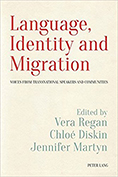
Regan, Vera; Diskin, Chloé and Martyn, Jennifer (eds.,). Language, Identity and Migration: Voices from Transnational Speakers and Communities. Peter Lang, 2016.
This volume presents a collection of the latest scholarly research on language, migration and identity. In a globalised world where migratory patterns are in constant flux, the traditional notion of the ‘immigrant’ has shifted to include more fluid perspectives of the migrant as a transnational and the language learner as a complex individual possessing a range of dynamic social and contextual identities. More information...

Gruba, Paul et al (eds.,). Blended Language Program Evaluation. Palgrave MacMillan, 2016.
Advocating an argument-based approach, Blended Language Program Evaluation presents a framework for planning, conducting, and appraising evaluation of blended language learning across three institutional levels, and demonstrates its utility and application in four case studies carried out in diverse international contexts. More information...
2015

Morton, J., Elder, C. and McNamara, T. “Pattern and particularity in a pedagogical genre: The case of an individual teacher,” in Duché, V., Do, T. and Rizzi, A. (eds.,). Genre, Text and Language: Mélanges Anne Freadman. Classiques Garnier, 2015.
To pay tribute to the work of Professor Anne Freadman, twenty-three specialists explore the question of genre. This volume focuses on teaching, and in particular the teaching of indigenous or foreign languages, semiotics, linguistics, and literature. More information...

Douglas, Susan and Stirling, Lesley. (eds.,). Children’s Play, Pretense, and Story: Studies in Culture, Context, and Autism Spectrum Disorder. Routledge, 2015.
At the heart of this volume is the recognition that children’s engagement with play and story are intrinsically and intricately linked. The contributing authors share a passionate interest in the development and well-being of children, in particular through their use of imagination and adaptation of the everyday into play and stories. More information...